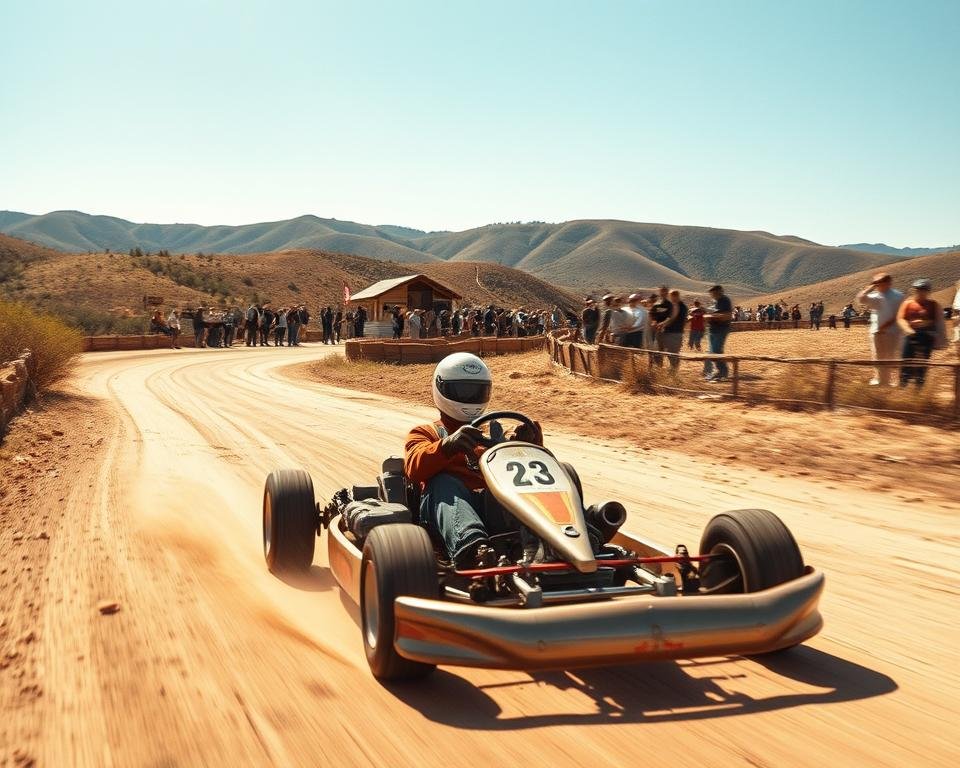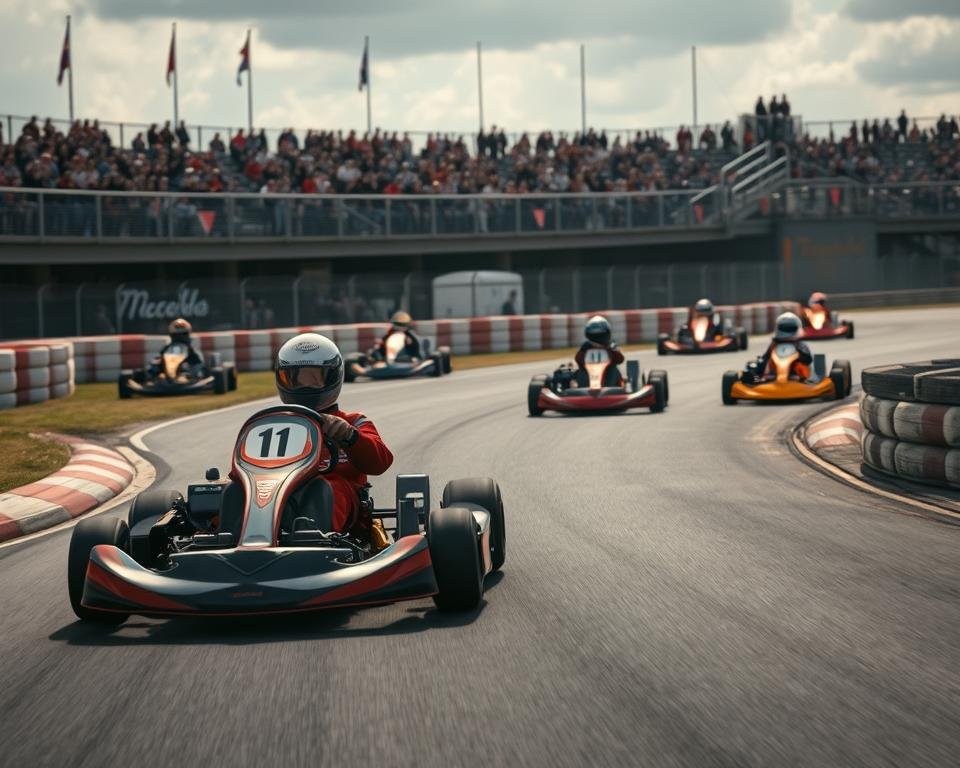What began as a garage project in 1950s California now fuels professional motorsports careers worldwide. Art Ingels sparked this revolution by building the first functional kart in 1956. His makeshift design—a welded frame paired with a lawnmower engine—proved even simple machines could deliver adrenaline-packed racing thrills.
By the 1960s, enthusiasts upgraded these backyard creations into purpose-built machines. Innovations like shifter karts and aerodynamic chassis transformed casual hobby activities into organized competitions. Manufacturers soon entered the scene, refining engines and safety features to attract broader audiences.
Today’s karting circuits serve as training grounds for future Formula 1 and NASCAR champions. Professional leagues now operate globally, backed by advanced engineering and standardized rules. Modern designs balance speed with accessibility, letting drivers as young as six experience competitive racing.
You’ll explore how grassroots passion and technical breakthroughs reshaped this sport. From Ingels’ prototype to today’s carbon-fiber models, every innovation expanded karting’s reach. Discover the pivotal moments that turned weekend fun into a multimillion-dollar industry.
Overview of Go-Kart Racing Evolution
A single DIY project in the 1950s laid the groundwork for a worldwide racing phenomenon. Art Ingels’ original kart design became the blueprint for a movement merging affordability with competition. Within a decade, backyard builders evolved into specialized manufacturers, creating standardized chassis and engines.
This shift turned weekend fun into structured sport. Regional clubs multiplied globally, organizing races that attracted both casual drivers and future professionals. Australia now hosts over 7,000 licensed competitors—just one example of karting’s international footprint.
Modern innovations keep the racing scene dynamic. Lightweight materials and precision engineering let today’s machines reach 80+ mph while maintaining safety. Iconic circuits like Charlotte Motor Speedway now feature dedicated karting tracks, blending grassroots appeal with professional-grade infrastructure.
You’ll see how three factors propelled this evolution: accessible thrills for new drivers, tech upgrades attracting sponsors, and youth development programs feeding pro leagues. These elements transformed karting from garage experiments to a $2 billion global industry—without losing its “run what you brung” spirit.
History and Origins: Art Ingels and Early Innovations
In 1956, a Southern California garage became the birthplace of modern karting when Art Ingels welded together history. As a fabricator for Kurtis Kraft—makers of five Indy 500-winning cars—he transformed racing expertise into a miniature marvel. His first kart featured a steel-tube chassis, mirroring full-size race car stability with a low profile and wide wheelbase.
Ingels’ garage-built prototype paired that lightweight frame with a McCulloch two-cycle engine, originally designed for lawn equipment. Collaborator Lou Borelli helped mount the 2.5-horsepower motor, proving surplus parts could power competitive racing. This DIY approach became karting’s signature: accessible engineering with professional-grade principles.
You’ll notice how Art Ingels’ Indy car background shaped every detail. The chassis supported adult riders despite its minimal weight, while the open-wheel design mimicked Grand Prix vehicles. Early test runs revealed flaws, sparking rapid iterations that defined karting development for decades.
By blending motorsport precision with garage tinkering, Ingels didn’t just build the first kart—he created a template for innovation. His work proved high-speed thrills didn’t require factory budgets, setting the stage for today’s global circuits.
The Birth of Karting in Southern California
Southern California’s car culture and sunbaked asphalt provided the ideal launchpad for motorsport’s most accessible discipline. When Art Ingels rolled his first kart into Pomona Raceway in 1956, he didn’t just showcase a novelty—he ignited a movement.

Ingels’ Garage Creation
The fabricator’s welded steel frame became karting’s founding blueprint. Powered by a repurposed lawnmower engine, this kart proved speed thrills could be achieved without factory budgets. Fellow enthusiasts like Duffy Livingston immediately recognized its potential, sparking a wave of garage-built replicas.
The First DIY Kart Designs
Livingston and partner Roy Desbrow transformed Ingels’ prototype into community property. Their modified versions spread through racing circles like wildfire, with early competitions erupting in supermarket parking lots. By 1957, Pasadena’s Rose Bowl hosted organized events—its vast concrete expanse perfect for testing homebuilt machines.
You’ll notice how southern California drivers turned limitations into advantages. Scrap materials became chassis, while vacant lots doubled as racing circuits. This grassroots ingenuity established karting’s DNA: affordable competition where creativity mattered as much as horsepower.
Expansion of Karting Across the United States
As karting exploded beyond California parking lots in the late 1950s, chaotic races demanded structure. What started as regional fun required standardized rules to keep competitions fair and machines safe. This shift turned scattered events into a nationwide phenomenon.
Grassroots Races and Local Tracks
Abandoned airfields and repurposed fairgrounds became hotspots for racing enthusiasts. Families built homemade karts using motorcycle engines and scrap metal, testing them on makeshift tracks. By 1960, over 100 dedicated circuits operated across the United States, from Texas dirt ovals to Florida asphalt courses.
Formation of Karting Associations
Attorney Don Broberick saw potential in this chaos. Merging SCCA regulations with grassroots spirit, he co-founded the Go Kart Club of America in 1959. This karting association introduced tech inspections, class divisions, and national championships—blueprints still used today.
The GKCA’s success sparked regional groups like the World Karting Association. These organizations standardized races while preserving local creativity. When Australia formed its own karting association in 1963, it proved the United States model worked globally.
You’ll find these structured tracks and governing bodies transformed backyard builds into professional pipelines. Today’s champions often trace their roots to these early national circuits.
International Growth and Global Racing Phenomenon
U.S. servicemen stationed in Europe during the 1960s became accidental ambassadors for karting. Their improvised races with American-built machines caught local attention, sparking a continental obsession. European engineers quickly upgraded designs, swapping lawnmower engines for motorcycle powerplants that doubled speed capabilities.
European Engineering Revolution
Italian manufacturers like Komet and Parilla redefined racing performance. Their purpose-built engines delivered 15+ horsepower—quadruple the output of early models. This innovation turned karts into legitimate training tools for future Formula 1 drivers.
Organizations like the World Karting Association standardized rules, enabling cross-border competitions. You’ll find modern circuits from Germany to Japan use identical class structures, letting talents progress seamlessly from local tracks to international events.
Asia’s Rising Karting Culture
Indonesia exemplifies karting’s global spread. Once a niche hobby, it now produces champions like Qarrar Firhand through youth academies. Brands such as Zanardi supply equipment to these programs, ensuring even remote regions access pro-grade technology.
Today’s drivers compete on a truly world stage. From Milanese engineers to Jakarta’s racetracks, every advancement strengthens karting’s position as motorsport’s universal gateway.
The Evolution of Go-Kart Racing: From Hobby to Sport
Accessible thrills and technical ingenuity transformed weekend tinkering into a structured motorsport discipline. Early enthusiasts welded scrap metal into makeshift karts, proving speed didn’t require deep pockets. This grassroots energy fueled a hobby that outlasted fleeting trends, evolving into organized competition.
By the 1970s, commercial manufacturers replaced garage builders. Standardized chassis and safety protocols turned chaotic races into professional events. Youth academies emerged, training future champions while keeping entry costs low. You’ll find today’s karting circuits balance high-speed racing with family-friendly accessibility.
Infrastructure upgrades cemented this shift. Dedicated tracks with timing systems replaced parking lot courses. Brands like Rotax introduced sealed engines, ensuring fair sport play. These changes attracted sponsorships, turning local races into televised spectacles.
What began as a fad now thrives as a dual-purpose phenomenon. Recreational drivers share pit lanes with pros eyeing Formula 1 seats. This unique blend—raw excitement meets career pathways—keeps karting relevant across generations.
Technological Advancements in Kart Design and Engines
Precision engineering transformed kart performance while keeping accessibility intact. Manufacturers now balance raw power with driver-friendly features, letting novices and pros push limits safely.
Powerplants Redefined
McCulloch’s chainsaw engine adaptations sparked a revolution. Modern units like SodiKarts’ sealed motors deliver 15+ horsepower without sacrificing reliability. These machines now dominate oval tracks, with left-turn tuning optimizing speed for competitive formats.
Specialized engines cater to unique needs—dark kart variants thrive in night races, while electric models gain traction. Ace Karts uses French-built powerplants featuring adjustable throttles, proving innovation drives both recreation and pro circuits.
Smart Frame Evolution
Today’s chassis designs prioritize safety without compromising agility. Lightweight chromoly steel frames absorb impacts, while rack-and-pinion steering sharpens handling. Adjustable seats and pedals let drivers customize positions for optimal control.
Integrated brake lights and reinforced roll bars showcase how karts blend racing thrills with modern safeguards. These upgrades ensure every lap—whether at local tracks or national events—remains thrilling yet accessible.

